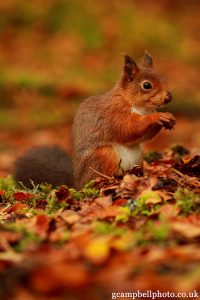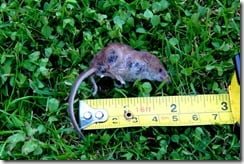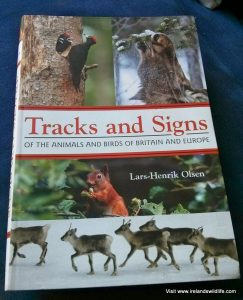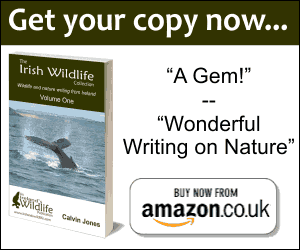
The red squirrel is Ireland’s only native squirrel, and perhaps the cutest member of the rodent family. This endearing little tree-dweller, with its characteristic bushy tail and ear-tufts, thrived in the large forests of Scots pine that were common in Ireland after the last ice age. In time these Scots pine forests dwindled and were replaced by deciduous species less suited to red squirrels.
Ireland’s native red squirrel population is thought to have become extinct towards the end of the 17th century. Our current population of squirrels is the result of reintroductions from England and Scotland between 1815 and 1856. Red squirrels are widespread, and can be found throughout the country, although they are being usurped by the larger, more aggressive grey squirrel in some areas of the midlands and the north. Grey squirrels are North American interlopers that were first introduced into Co. Longford between 1911 and 1913, and their population is gradually spreading.
Red squirrels are between 18 and 24cm (7 and 9.5 inches) long, not including the bushy tail, which adds a further 14-20cm (5.5-8 inches) to their length. Adult reds weigh between 250 and 350 grams (9 and 12.5 ounces) and in the wild live for a maximum of 7 years. There is a great deal of colour variation in red squirrel populations with coats ranging from a warm red-brown in the summer to a dark chocolate-brown with grey in winter. Coats also vary within populations, and in any given area you could see squirrels exhibiting coat colours from almost black, through various shades of red to buff.
Large patches of conifer forest are the reds’ preferred habitat, although in the absence of competition from grey squirrels they will colonise less suitable deciduous woodland. Their favourite source of food is the seeds hidden inside the cones of pine and spruce trees, which they get at by gnawing away at the cone. A forest floor littered with gnawed pine-cones that resemble apple cores is a sure sign that there are squirrels present. Reds will also eat acorns, berries, fungi, and will strip away tree bark to get at the sweet sappy tissue underneath. When food is plentiful surplus is often stored to see the squirrel through leaner times.
Red squirrels are active during the day, and sleep at night in spherical nests called dreys. Dreys usually consist of a twig frame lined with soft mosses and grass, and are built at least six metres (c. 20 foot) from the ground. Each squirrel will typically use several dreys within a home range of some 7 hectares. Squirrels are not territorial: home ranges often overlap and it is common to see several squirrels foraging in the same area of forest.
Although widespread and still relatively common, red squirrels are notoriously difficult to spot. They tend to spend most of their time high in the forest canopy, using their tails as a versatile balancing aid while traversing narrow branches and leaping acrobatically from tree to tree. The long, bushy tail is what gives the squirrel its Latin name Sciurus, which comes from the Greek skai, which means shadow, and oura, which means tail – presumably from the squirrel’s habit of sitting upright, its tail curved over its back and head: literally sitting in the shadow of its own tail.
Contrary to popular belief, squirrels do not hibernate in winter and remain active throughout the year. However, when the weather is particularly bad they can stay in their dreys for days at a time to conserve energy. Red squirrels usually mate between January and March and have a litter of 1-8 (usually 3) kittens after a gestation period of 36-42 days. Only females are involved in caring for the young. When conditions are favourable red squirrels can have two litters per year.
The red squirrel’s natural predators include pine martens, sparrow hawks and feral cats, although the main threat to the Irish population is the continued encroachment of grey squirrels into territories traditionally occupied by reds.
Photo Credit: ![]() All rights reserved by gcampbellphoto via the Ireland’s Wildlife group on Flickr
All rights reserved by gcampbellphoto via the Ireland’s Wildlife group on Flickr










3 comments
Eddy
Spotted 2 red squirrels Wicklow Dublin mountains near glencree as I was cycling along road
October bank holiday
Robbie thornton
Hi.
Would a grey squirrel eat a mouse ? I saw one last year kill and take a mouse up a tree .
Jill Dinsdale
Hi Calvin. Just to let you know, I saw a red squirrel in Burgatia, Rosscarbery, yesterday. First time I have seen one here.